EVGA's GeForce GTX 285 Mac Edition: The Best for OS X?
by Anand Lal Shimpi on July 17, 2009 7:00 PM EST- Posted in
- GPUs
Upgrading anything other than memory or hard drives in a Mac is ridiculously frustrating. Most of Apple’s machines use mobile CPUs soldered on to the motherboards, which makes swapping chips an impossible affair. And the ones that don’t use mobile chips have other supermodel quirks associated with them, like being lidless.
Upgrading Mac video cards has always been an unreasonable pain. Mac versions of PC GPUs have always been ridiculously overpriced and taken far too long to come out. Apple still sells an ATI Radeon X1900 XT upgrade kit for the Mac Pro, for $399. Do I even need to point out how disappointing that is?
Lately Apple has been getting a bit better with GPU releases. The 8800 GT and even more recently, the Radeon HD 4870 have both been build-to-order GPU options directly from Apple. Even more awesome is that once Apple officially supports a conventionally PC video card, it just takes one user to dump the ROM from the Mac version and now we all have a way of hacking PC cards to become Mac editions.
In a completely surprising move however, EVGA has released a GeForce GTX 285 Mac Edition. Prior to this release, all 3rd party video card upgrades were branded either by ATI or NVIDIA - Apple doesn’t really support the upgrade market the way the PC industry does. What EVGA has done is given Mac users a very high end GPU option that they can buy from Apple.com or through a handful of other online vendors.

Why do you even need a GeForce GTX 285 Mac Edition? The hardware is identical to what you get (for $100 less) when you buy a PC card, the difference is in the packaging and firmware.
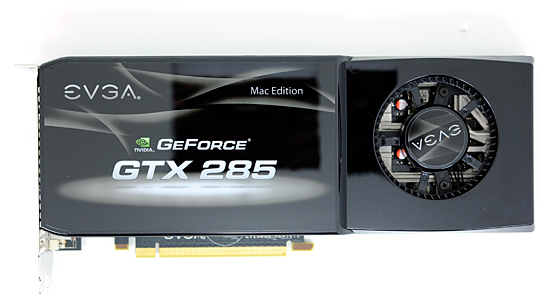
These cards are only useful in the Mac Pro, but the standard video card in any Mac Pro doesn’t require any additional PCIe power connectors. If you upgrade to a more power hungry video card, you’ll need one or two cables that connect the small PCIe power connectors on the Mac Pro’s motherboard to the connectors on the video card itself. These come in the GTX 285 Mac Edition box.
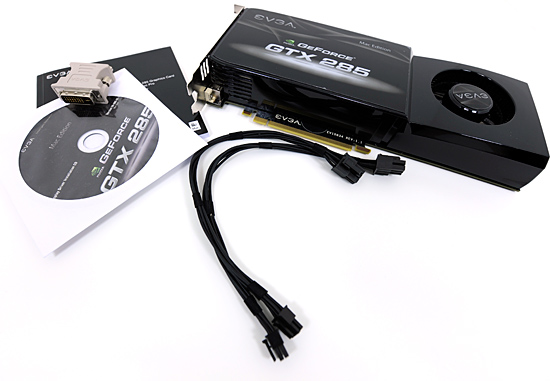
What's in the box
The other change is firmware. In order to get your PC video card to work under OS X it needs firmware with a few EFI hooks in it. It’s not a huge change, but for whatever reason the PC specific cards don’t have it. Now you can do some Googling (or Binging) and find ROM dumps for various PC cards that will enable Mac operation, or you can buy a card that comes EFI equipped from the factory.
EVGA is offering the latter, a GeForce GTX 285 with firmware that will allow it to POST and function under OS X without any modifications. It’ll also work just fine in Windows using Boot Camp.
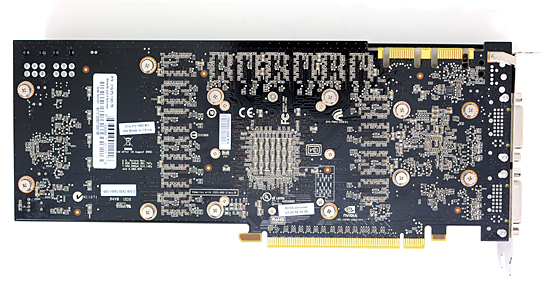
The price is a bit hefty at $449.99, especially considering that you can buy the PC firmware enabled GTX 285 from EVGA for around $330. The EVGA bundle does come with the two necessary power cables, which you’d have to buy separately if you were going the hack-your-own route; they absurdly retail for $30 a cable.

Looks can be deceiving, one end is a normal PCIe power connector, the other end is tiny PCIe power
Unlike some earlier ATI Mac Edition cards, the GTX 285 ships with the exact same clocks as the PC version. The card even looks identical, the PCB even has a useless pair of SLI bridge connectors on it.
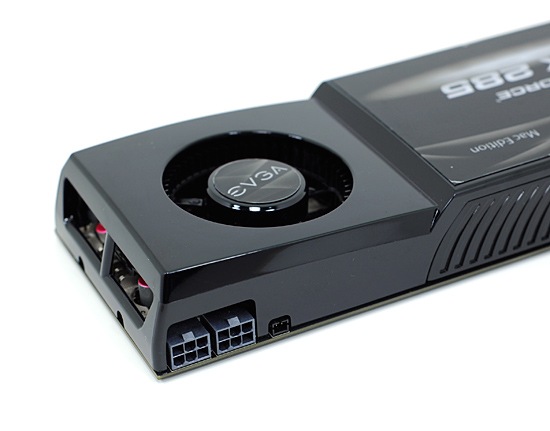
The bundle comes with a driver CD (yes, you’ll be needing it), a pair of power cables and a lone DVI to VGA adapter. Using VGA on a Mac, I’m pretty sure, is some sort of sacrilege but you can do it thanks to EVGA.
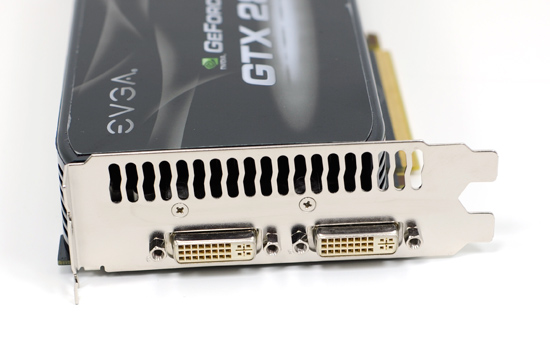
The card itself has two dual-link DVI outputs on it; there’s no support for mini-DisplayPort so owners of the new 24” LED Cinema Display are out of luck. The advantage that the EVGA card has over the two current BTO options on the Mac Pro is that you do get two dual-link DVI ports, something that you don’t get out of either of Apple’s options. Furthermore, it’s quite disappointing that Apple doesn’t offer the EVGA card as a BTO option on the new Mac Pro - it’s easily the most powerful GPU officially supported by Apple, yet it’s barred from coming pre-installed on the most powerful Mac.










48 Comments
View All Comments
bupkus - Saturday, July 18, 2009 - link
For so very long linux never could claim itself a good platform for games. So I'm thinking, admittedly quite wishfully, that the OS X's linux roots could provide a trail for drivers in OS X to become useful in linux.What say you experts on this matter?
erple2 - Saturday, July 18, 2009 - link
OSX isn't based on Linux. It's based on a BSD flavor. I'm not sure if it's NetBSD or OpenBSD (I think NetBSD). Which is very different from Linux.Kurotetsu - Tuesday, July 21, 2009 - link
Well, according to Wiki (which means you should take it with some salt), it was both:Mac OS X is based upon the Mach kernel.[8] Certain parts from FreeBSD's and NetBSD's implementation of Unix were incorporated in Nextstep, the core of Mac OS X. Nextstep was the object-oriented operating system developed by Steve Jobs' company NeXT after he left Apple in 1985.[9]
http://en.wikipedia.org/wiki/Mac_OS_X">http://en.wikipedia.org/wiki/Mac_OS_X
sprockkets - Tuesday, July 21, 2009 - link
Yes, this is true. The BSD part is just for POSIX compliance. Even though OSX is certified UNIX, Apple saying it is UNIX stable is a bit disingenuous, as the part of the kernel doing all the work is all Apple, not UNIX or BSD.8steve8 - Friday, July 17, 2009 - link
means can't connect to the LED 24" display apple makes.weird.
Natfly - Saturday, July 18, 2009 - link
I would think a standard dvi -> mini-displayport adapter would work, right?http://www.monoprice.com/products/product.asp?c_id...">http://www.monoprice.com/products/produ...2&p_...
BrianMCan - Monday, July 20, 2009 - link
no, that is to connect a DVI monitor to mini-displayport computer.to go the other way it would have DVI male, to mini-displayport female.
Demon-Xanth - Friday, July 17, 2009 - link
...the markup on those cables is the most I've seen outside of audiophile or specialty cables.
Connectors:
4x Molex 45559-0002 $0.30ea, $0.14/ea in quantities of 5000
24x Molex 44476-1111 $0.12ea, $0.05/ea in quantities of 4000
12' 18AWG stranded wire (assuming the cables are 12") $38/100 foot spool, $145 for 1000'
(prices from Mouser, distributors may be much lower)
Low quantity cost: About $8 for the pair.
Higher quantity cost: About $3 for the pair.
Admittedly, the crimp tool itself runs about $320, so given the $52 profit margin, it should take about 7 sets to end up in the black.
rpmurray - Tuesday, July 21, 2009 - link
I'd go with the higher quality pair, according to you they're $5 cheaper then the low qualityDemon-Xanth - Thursday, July 23, 2009 - link
Quantity, not quality.The parts are $8 for two if you built one set. $3 for two if you build 1000 sets.